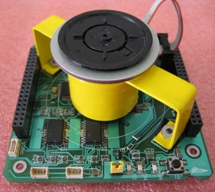SATEDU SUBSYSTEMS
The Educational Satellite prototype (SATEDU) consists of the following microcontroller based intelligent subsystems. All of them were fully designed, manufactured and validated at the Institute of Engineering, UNAM. ______________________________________________________________________________ |
|
FLIGHT COMPUTER SUBSYSTEM  |
The flight computer (FC) contains a 20 MHz SAB80C166 16 bit Siemens Microcontroller. This subsystem coordinates all SATEDU subsystems. In addition, the FC includes a 16F876 PIC microcontroller to control signal lines from SAB processor during new program uploading, 8 RS232 serial ports, 32 Mb of flash memory, 3 1-wire temperature sensors and 3 latch-up protection modules for radiation protection. |
POWER SUBSYSTEM |
The intelligent Power Subsystem has a 18F2321 PIC microcontroller which communicates with the Flight Computer for energy managing purposes. This subsystem is composed by 2 electronic cards. The first one includes mainly 4 Li-ion batteries, while the second one contains a PIC microcontroller, electronics for battery charging and solid state microswitches for energy control. The battery charging module accepts two energy supply sources, one from solar panels attached to SATEDU and another one from an inexpensive AC line adaptor. This feature contributed to reduce the cost of SATEDU system. |
STABILIZATION SUBSYSTEM |
The Stabilization Subsystem consists of a card that handles two methods of active stabilization, the main one is based on an inertial/reaction wheel while the second one employs magnetic torquer coils (BTM). The core of this subsystem is a 10 MHz 18F4431 PIC microcontroller driving 7 H bridges by PWM, a DC brushed motor, 16 ppr encoder and DC motor over-current sensor. The stabilization system integrates two operation modes: open loop and closed loop. With the first mode three RPM modulation signals can be generated: swath tooth, triangular, and senoidal. These modes are very useful for the users to easily observe SATEDU operation as well as its effects in terms of physical coordinated attitude changes (when the prototype is suspended from the ceiling with a string). |




